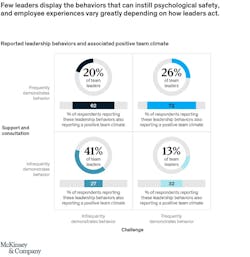Leaders Need to Provide Psychological Safety for Employees
As the pandemic has demonstrated, business runs better when employees feel a high level of trust in their company. They need to feel comfortable to ask for help or offer new ways of thinking to adjust to a new normal. However, not many leaders are able to demonstrate the positive behaviors that can provide psychological safety for workers, according to a recent McKinsey Global Survey.
Their research has shown that a “positive team climate—in which team members value one another’s contributions, care about one another’s well-being and have input into how the team carries out its work—is the most important driver of a team’s psychological safety.”
To help leaders create leadership that enhances psychological safety, McKinsey recommends the following actions:
- Go beyond one-off training programs and deploy an at-scale system of leadership development. While the delivery of learning may be sequenced as a series of trainings—and rapidly codified and scaled for all leaders across a cohort or function of the organization—those trainings will be even more effective when combined with other building blocks of a broader learning system, such as behavioral reinforcements.
- Invest in leadership-development experiences that are emotional, sensory and create aha moments. It's critical that learning programs prompt leaders to engage with and shift their underlying beliefs, assumptions and emotions to bring about lasting mindset changes. Companies can begin with facilitated experiences that push learners toward personal introspection through targeted reflection questions and small, intimate breakout conversations.
- Build mechanisms to make development a part of leaders’ day-to-day work. The organization’s most senior leaders need to be the first adopters of putting real work at the core of their development, which requires senior leaders to role model—publicly—their own processes of learning. These examples become strong signals for leaders across the organization that it is safe to be practicing, failing and developing on the job.
About the Author
EHS Today Staff
EHS Today's editorial staff includes:
Dave Blanchard, Editor-in-Chief: During his career Dave has led the editorial management of many of Endeavor Business Media's best-known brands, including IndustryWeek, EHS Today, Material Handling & Logistics, Logistics Today, Supply Chain Technology News, and Business Finance. In addition, he serves as senior content director of the annual Safety Leadership Conference. With over 30 years of B2B media experience, Dave literally wrote the book on supply chain management, Supply Chain Management Best Practices (John Wiley & Sons, 2021), which has been translated into several languages and is currently in its third edition. He is a frequent speaker and moderator at major trade shows and conferences, and has won numerous awards for writing and editing. He is a voting member of the jury of the Logistics Hall of Fame, and is a graduate of Northern Illinois University.
Adrienne Selko, Senior Editor: In addition to her roles with EHS Today and the Safety Leadership Conference, Adrienne is also a senior editor at IndustryWeek and has written about many topics, with her current focus on workforce development strategies. She is also a senior editor at Material Handling & Logistics. Previously she was in corporate communications at a medical manufacturing company as well as a large regional bank. She is the author of Do I Have to Wear Garlic Around My Neck?, which made the Cleveland Plain Dealer's best sellers list.
Nicole Stempak, Managing Editor: Nicole Stempak is managing editor of EHS Today and conference content manager of the Safety Leadership Conference.

